
Global Economy in Week 33: U.S. inflation and the RBA policy meeting
Global markets digested a soft U.S. July jobs report, mixed ISM surveys, and a surprise Bank of England rate cut vote ratio, while oil slid and gold spiked amid tariff confusion. U.S. nonfarm payrolls rose just +73k in July and the unemployment rate ticked up to 4.2%, pointing to a gradual cooling in labor conditions. Manufacturing slipped (ISM 48.0) and services slowed to near-stall speed (ISM 50.1).
Outside the U.S., the BoE cut Bank Rate by 25 bp to 4.0% in a close 5–4 vote. China’s July CPI was 0.0% y/y with PPI still deeply negative, underscoring subdued domestic demand.
In commodities, WTI fell about 5% w/w to ~$63.4 on tariff jitters and chatter of U.S.–Russia talks, while gold futures hit a record after reports that one-kilogram bars could face U.S. tariffs; the White House later said it would “clarify.” The dollar edged lower on the week as markets priced additional Fed easing.
Week ahead: A heavy U.S. macro slate—CPI (headline seen 2.8% y/y; core ~3.0%), PPI, retail sales, industrial production, and University of Michigan sentiment. Elsewhere, the RBA sets policy on Tuesday, Norges Bank meets Thursday, China releases industrial production and retail sales on Friday, and the U.K. delivers a busy docket (CPI, GDP, and labor-market data).
United States — Economic Review and Outlooks
Review
The macro tone softened last week. July nonfarm payrolls rose to +73k (reported Friday, August 1), prior months were revised down a net -258k, and the unemployment rate ticked up to 4.2%. Wage growth remained firm, but the overall picture reinforced a “slow glide” normalization rather than a recession, consistent with labor markets cooling after the strength of 2023–24.
High-frequency data signaled mixed growth. ISM Manufacturing fell to 48.0 (fifth straight month below 50), with the employment index at 43.4, pointing to continued factory headcount contraction. ISM Services eased to 50.1; new orders at 50.3 barely held in expansion, while services employment slipped to 46.4. Price components in both surveys stayed sticky enough to keep the Fed cautious, but the momentum clearly slowed.
Markets leaned risk-on into week’s end. Equities rallied as investors focused on the “soft-Ish” macro backdrop and rising odds of additional Fed cuts this year. Nasdaq closed at a record, the S&P 500 gained roughly 2.4% on the week, and the Dow rose about 1.3%. Earnings season supported sentiment: beat rates and surprise magnitudes are tracking above 10-year averages, helping sustain multiples despite tariff headlines.
In FX, the DXY was on track for a ~0.5% weekly decline as markets priced more 2025 easing.
Overall, U.S. growth is cooling—not crashing. Softer jobs and cooler ISMs put the spotlight on Week 33 inflation and activity releases to confirm whether disinflation is resuming, and demand resilience persists. Equities remain underpinned by solid earnings; rates and the dollar hinge on CPI/PPI.
United States — Economic Outlook: Key Data, Wall Street & USD
Key data this week: CPI (Wed), PPI (Thu), Retail Sales (Fri), Industrial Production (Fri), and University of Michigan sentiment (Fri).
CPI: After a weak jobs report, inflation is the main focus. We expect core CPI to rise 0.3% m/m, the strongest in six months—lifting core y/y back to roughly 3.0% as firmer goods prices are no longer fully offset by softer services. Headline CPI likely increases 0.2% m/m on lower gasoline and calmer food inflation. Tariff pass-through is building, but consumer fatigue is constraining pricing power. Base case: inflation firms without re-accelerating; core runs near a 3% annual pace into Q4.
Retail Sales: Headline sales are tracking around +0.6% m/m, flattered by a rebound in auto sales and slightly higher prices. Ex-autos: +0.3%. After inflation, July retail sales are roughly flat, with households getting choosier and trimming discretionary spending amid a cooler labor market and tariff concerns.
Industrial Production: We look for a flat m/m print. Utilities likely retrace last month’s surge; manufacturing is mixed. “Hard” activity has held up better than soft surveys, but traditional capex (plants/equipment) is slowing amid uncertainty. Investment remains concentrated in software and information processing—consistent with AI-related adoption.
Wall Street:
Earnings remain supportive, and the BoE’s cut reinforces a global easing bias, so stocks begin the week with a constructive tone. An upside CPI surprise could pressure long-duration tech and compress multiples; an in-line/softer CPI would extend the “goldilocks” bid and support cyclicals if retail sales/industrial production improve. Watch leadership breadth: Mega cap tech versus a potential catch-up in financials and industrials. Technically, bulls still have the upper hand; a pivot near 21,000 with resistance around 22,000 is the near-term map.
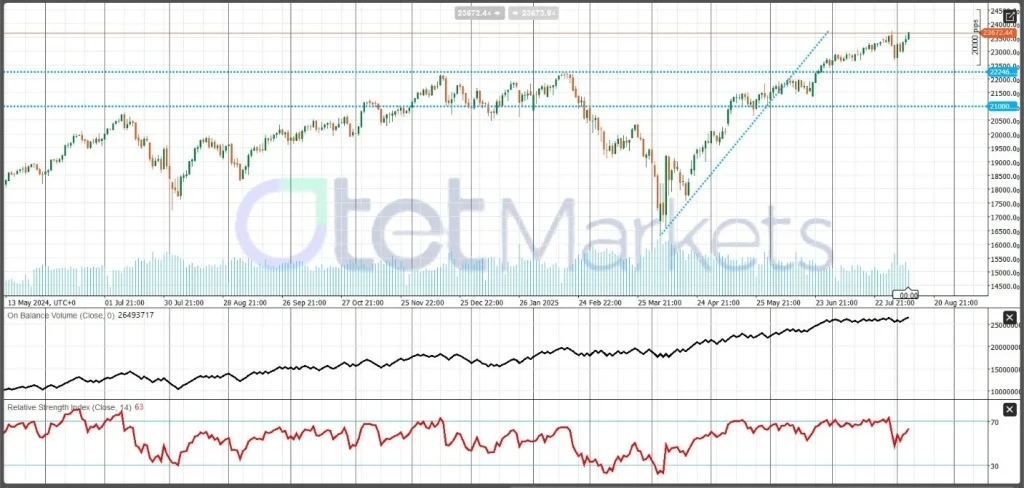
USD (DXY):
After a ~0.5% weekly pullback, CPI is the swing factor. A hotter core (≥3.1% y/y) likely lifts front-end yields and supports the dollar; a cooler print (≤2.9%) should pressure the DXY and favor risk-on trades (EM FX, commodities), especially with markets already leaning toward additional 2025 Fed cuts. Technically, DXY looks range-bound 96–98; a sustained break above 98 opens the door toward 101, while a decisive move below 96 would likely require a heavier macro shock.
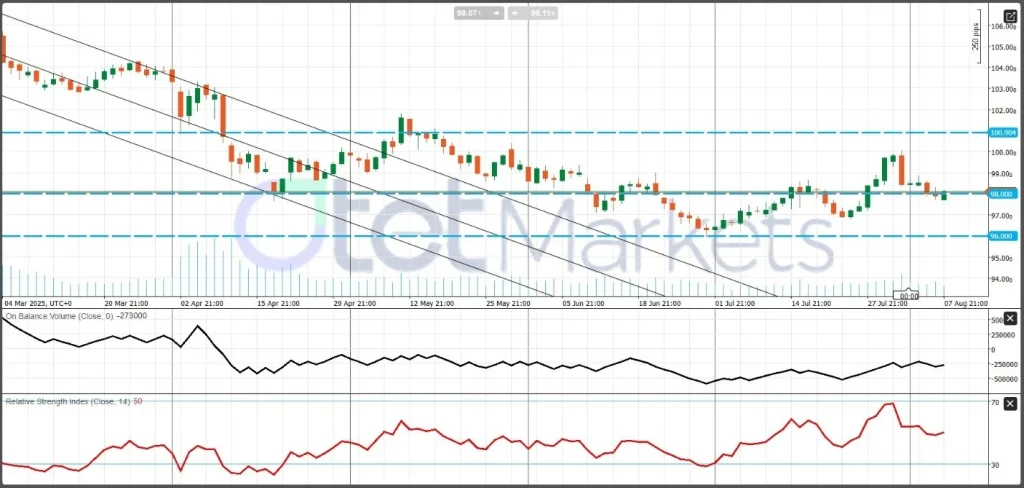
Australia — RBA in Focus
Australia’s macro backdrop has softened enough to tilt policy. Q2 CPI slowed to 2.1% y/y (trimmed mean 2.7%), June unemployment edged up to 4.3%, and June retail turnover rose +1.2% m/a short-term lift that doesn’t change the broader consumption downshift. Together, these prints have markets leaning toward RBA easing.
RBA (Tue, Aug 12): Consensus looks for a 25 bp cut to 3.60%, with guidance leaving the door open to another move by year-end. The Statement on Monetary Policy should pair the decision with softer growth profiles and a still-gradual disinflation track—consistent with a measured easing cycle into early 2026. Our base case: a 25 bp cut this week, followed by additional November and February reductions, taking the cash rate to ~3.10% by Q1 2026. The Board remains in wait-and-see mode, emphasizing a gradual, data-dependent approach given global uncertainty.
What to watch in the statement
- Labor-market slack (underemployment, hours worked)
- Services-inflation stickiness versus softer tradables
- Household cash-flow dynamics and mortgage-reset risks
- The weight given to global tariff headwinds on domestic demand
AUD — expected reaction:
A well-telegraphed 25 bp cut likely elicits a mild, knee-jerk AUD dip, especially if guidance hints at further easing. Two caveats:
- U.S. CPI arrives roughly 24 hours later and could dominate DXY direction; a softer USD would limit AUD downside.
- If the RBA tone is cautious but incremental (no rush into a deep cycle), AUD may stabilize or even firm on a “sell-the-rumor, buy-the-fact” dynamic. Near-term moves should track global risk sentiment.
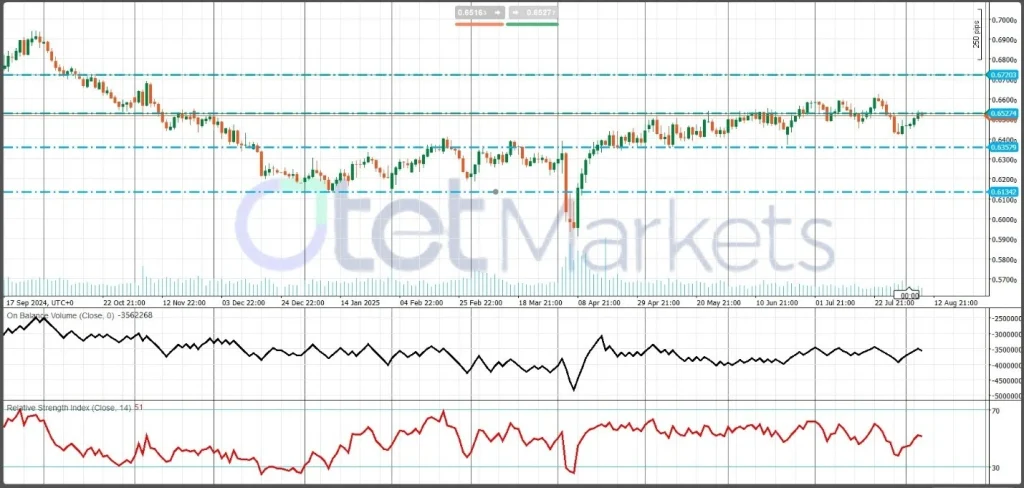
Levels:
We see AUD/USD capped in a 0.635–0.653 range near term. A clean break below 0.635 opens risk toward 0.613. Conversely, a sustained break above 0.660 points to an extension toward 0.670+.
Gold (XAU) Weekly Review & Outlook
Gold dominated headlines last week. Spot briefly traded above $3,410 and settled near $3,400, while U.S. futures printed a record intraday high around $3,534/oz and settled near $3,491. The spark was reports that U.S. Customs reclassified one-kilo/100-oz bars, potentially exposing standard bullion to steep tariffs—a particular issue for Swiss-refined metal. As logistics seized up and some shippers paused U.S. deliveries, the futures–spot spread widened, and volatility jumped. A softer DXY added an extra tailwind.
Policy clarity matters. If authorities exempt standard bullion bars, futures premia should narrow, and the squeeze should fade. An affirmation of tariffs, by contrast, risks persistent dislocations and an inventory shift toward London/Asia hubs.
Macro catalysts. This week’s U.S. CPI/PPI are pivotal. A benign CPI—especially core ≤2.9% y/y—would likely pull yields and the dollar lower, supporting gold. An upside-showing surprise could trigger a tactical pullback.
Positioning & narrative. Expect two-way trade as systematic strategies recalibrate after the spike. Macro hedgers remain active on “insurance” demand (tariffs/geopolitics), but price action is headline sensitive. There’s also a growing debate over gold’s safe-haven appeal at elevated prices: as a non-yielding asset, the carry becomes more burdensome if the Fed doesn’t deliver further near-term cuts.
Levels & risks. Elevated realized volatility argues for wider ranges. If tariffs are clarified away and CPI is tame, dipping into the $3,300s should attract buyers. If policy uncertainty lingers and inflation proves sticky, a re-test of $3,450–$3,500 is plausible.

WTI Crude — Weekly Review & Outlook
WTI fell about 5.1% w/w to roughly $63.4, its steepest weekly drop since late June, as tariff-driven demand worries and chatter about potential U.S.–Russia talks weighed on sentiment. Mid-week, the EIA reported a 3 mb crude draw and refinery runs near 96.9%, which briefly steadied prices, but the macro-overhang reasserted itself into Friday’s close.
Drivers. Normally, a draw alongside tight products stocks would support crack spreads and WTI. This time, markets fixated on growth/flow risks—new or proposed tariffs that could sap trade and ongoing uncertainty around Russia-related supply dynamics. Both Brent and WTI finished the week down more than 4%.
What to watch next.
- The next EIA weekly: do refinery runs stay elevated and does Cushing rebuild? A second straight draw would help anchor prices in the low-$60s.
- Monthly outlooks: the EIA Short-Term Energy Outlook, plus the IEA and OPEC oil reports. Any upgrade to demand or downgrade to supply would be price-positive—and vice versa.
Macro & geopolitics. Any concrete developments on U.S.–Russia relations or clarity on secondary sanctions could whipsaw the term structure. Base case remains range-bound $60–$70 while demand anxiety lingers. A softer U.S. CPI would aid risk assets and crude; a hot print risks another leg lower on growth fears.
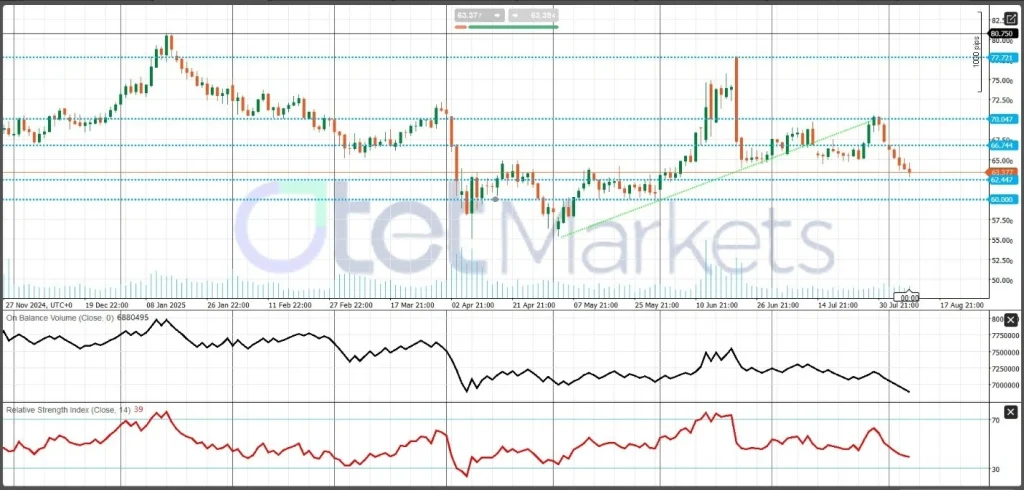
Risk skew & strategy. Near-term downside tails are tied to tariffs and slower demand; upside tails require firm drawing or policy headlines that ease supply-chain risks. Tactically, a range-trading approach—fade extremes within $60–$70—looks sensible. Initial support ~$62 and resistance ~$67; a break of either likely invites a test of the range edges.
Bitcoin (BTC) Weekly Review & Outlook
BTC was relatively calm compared with metals and oil, trading mostly in a $114k–$118k range and finishing near $116.6k. A Dow Jones/Morningstar read showed -0.9% on Friday, consistent with chops rather than trend. Correlations re-tightened with mega-cap tech as the Nasdaq notched a record.
Drivers. Softer U.S. data and a slightly weaker dollar provided a mild tailwind, helping BTC hold recent gains. Tariff headlines created cross-asset noise but had limited direct impact on crypto. Bigger picture: after July’s push above $120k and subsequent pullback, leverage looks modest, and dips are being absorbed—evident in intraday resilience.
Outlook. As with other risk assets, U.S. CPI is the pivot. A cooler print likely extends risk-on and could carry BTC back toward $118k–$120k; a hotter core risks a risk-off move toward $112k–$114k support.
What to watch. Keep an eye on ETF inflows and whether last week’s equity leadership broadens—higher beta helps BTC. Expect event-risk volatility to stay elevated into Wednesday; post-CPI, look for realized vol to mean-revert unless fresh tariff headlines re-ignite cross-asset swings.
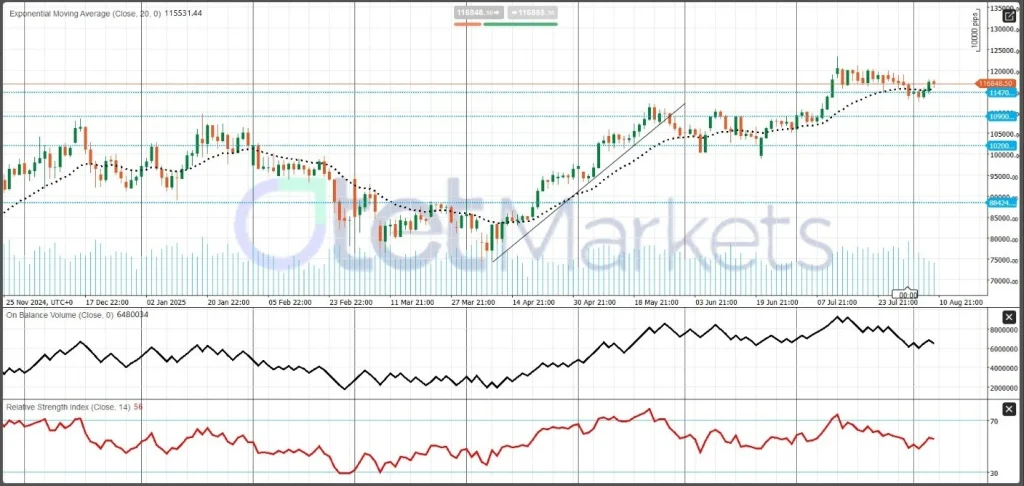
Share
Hot topics

Best Forex Trading Hours for Iranian Traders
The Forex market operates 24-hours a day, but clearly not every hour, equal it could even be every trading session, is profitable. There are times when the market sleeps, is...
Read more




Submit comment
Your email address will not be published. Required fields are marked *